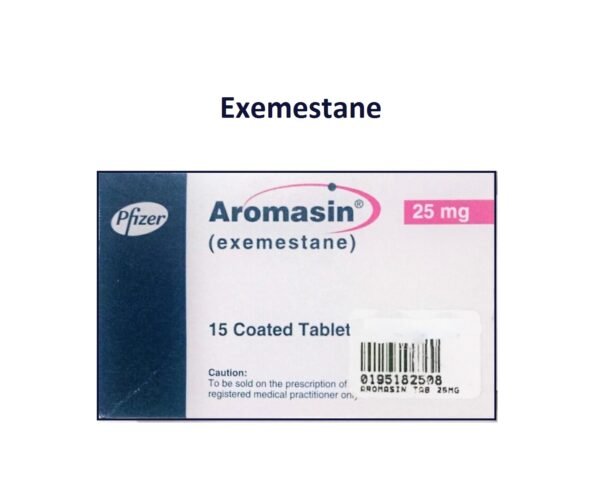Exemestane is a medication used in the treatment of breast cancer. It falls under the category of aromatase inhibitors, which are drugs that inhibit the activity of the enzyme aromatase. Aromatase is responsible for converting androgens (male hormones) into estrogens (female hormones) in various tissues, including in postmenopausal women. Breast cancer growth is often fueled by estrogen, so by reducing estrogen levels in the body, the growth of estrogen-sensitive breast cancers can be slowed or inhibited.
Exemestane (Aromasin) is an irreversible steroidal aromatase inhibitor that is used in the treatment of breast cancer in postmenopausal women.
Exemestane (Aromasin) Uses:
- Breast cancer:
- It is used for the treatment of advanced breast cancer in postmenopausal women whose disease has progressed following tamoxifen therapy;
- adjuvant treatment of postmenopausal women with estrogen receptor-positive early breast cancer following 2 to 3 years of tamoxifen (for a total of 5 consecutive years of adjuvant therapy).
- Off Label Use of Exemestane in Adults:
- Used for the first-line adjuvant treatment of estrogen receptor-positive early breast cancer in postmenopausal women.
- Used in postmenopausal women for Risk reduction for invasive breast cancer.
Exemestane (Aromasin) Dose in Adults
Exemestane (Aromasin) Dose in the treatment of advanced Breast cancer:
- Exemestane is a medicine for advanced breast cancer in women who have stopped having periods.
- They should take 25 mg by mouth every day and keep taking it until the cancer gets worse.
Exemestane (Aromasin) Dose in the treatment of Early-stage Breast cancer (adjuvant treatment):
- For women who have gone through menopause, the dose of Exemestane is 25 mg taken by mouth once a day.
- This is done after they have already taken tamoxifen therapy for 2 to 3 years.
- They should continue taking Exemestane for a total of 5 years as part of hormone therapy, as long as the cancer doesn't come back or appear in the other breast.
Duration of therapy:
- Doctors usually recommend a maximum of 5 years of treatment with this kind of medicine for women who have gone through menopause.
- They might also combine this medicine with tamoxifen for a total of up to 10 years of hormone therapy.
- In a study, using a similar medicine (letrozole) for 10 years instead of 5 years showed better results in terms of preventing the cancer from coming back, but it didn't significantly affect overall survival.
- However, there were more bone-related side effects with the longer treatment.
Exemestane (Aromasin) Dose in the treatment of Early-stage Breast cancer, (first-line adjuvant treatment; off-label):
- Women who have gone through menopause can take Exemestane by mouth, 25 mg once a day, for 5 years.
The ASCO guidelines suggest:
- A maximum of 5 years using medicines like Exemestane for women who have gone through menopause.
- You can also combine Exemestane with another drug, tamoxifen, for up to 10 years of hormone treatment.
There was a study using a similar drug, letrozole. Taking it for 10 years (instead of just 5 years) showed better results in stopping cancer from coming back, but there were more side effects related to bones. Also, using it longer didn't make people live longer.
Exemestane (Aromasin) Dose in the treatment of Breast cancer, risk reduction (off-label):
For reducing the risk of breast cancer in women who haven't yet had it but are at high risk:
- Women who have stopped having periods and are 35 years or older should take Exemestane by mouth, 25 mg once a day, for 5 years.
If they're also taking certain strong drugs that affect how Exemestane works (like rifampin or phenytoin), the dose of Exemestane should be increased to 50 mg once a day.
Use in Children:
Not indicated.
Exemestane (Aromasin) Pregnancy Risk Category: X
- Exemestane shouldn't be used by women who are still having periods.
- It can harm an unborn baby if taken by a pregnant woman.
- So, women who can still have babies should use effective birth control during treatment and for 1 month after stopping Exemestane.
- It's also a good idea for these women to take a pregnancy test before starting the medicine to make sure they're not pregnant.
Breastfeeding:
- Exemestane should only be used by women who have stopped having periods.
- Because it can cause harm to a baby who is breastfed, mothers shouldn't breastfeed while taking Exemestane and for 1 month after they stop taking it.
Exemestane (Aromasin) Dose in Kidney Disease:
- You don't need to change the dose for people with kidney problems.
- However, we don't have enough information about long-term safety in those with serious kidney issues, but it seems no dose change is needed.
Exemestane (Aromasin) Dose in Liver disease:
No adjustment required (although the safety of chronic doses in patients with moderate-to-severe renal impairment has not been studied, dosage adjustment does not appear necessary).
Side Effects of Exemestane (Aromasin):
- Cardiovascular:
- Hypertension
- Edema
- Ischemic Heart Disease
- Chest Pain
- Central Nervous System:
- Fatigue
- Insomnia
- Pain
- Headache
- Depression
- Dizziness
- Anxiety
- Paresthesia
- Carpal Tunnel Syndrome
- Confusion
- Hypoesthesia
- Dermatological:
- Hyperhidrosis
- Alopecia
- Dermatitis
- Pruritus
- Skin Rash
- Endocrine & Metabolic:
- Hot Flash
- Weight Gain
- Increased Follicle-Stimulating Hormone
- Increased Luteinizing Hormone
- Increased Sex Hormone Binding Globulin
- Gastrointestinal:
- Nausea
- Abdominal Pain
- Diarrhea
- Vomiting
- Anorexia
- Constipation
- Increased Appetite
- Dyspepsia
- Genitourinary:
- Urinary Tract Infection
- Hematologic & Oncologic:
- Lymphedema
- Hepatic:
- Increased Serum Alkaline Phosphatase
- Increased Serum Bilirubin
- Infection:
- Infection
- Neuromuscular & Skeletal:
- Arthralgia
- Back Pain
- Limb Pain
- Myalgia
- Osteoarthritis
- Weakness
- Osteoporosis
- Pathological Fracture
- Muscle Cramps
- Ophthalmic:
- Visual Disturbance
- Renal:
- Increased Serum Creatinine
- Respiratory:
- Dyspnea
- Cough
- Flu-Like Symptoms
- Bronchitis
- Pharyngitis
- Rhinitis
- Sinusitis
- Upper Respiratory Tract Infection
- Miscellaneous:
- Fever
Contraindications to Exemestane (Aromasin):
- If someone is allergic to exemestane or any part of the medicine, they shouldn't take it.
Warnings and precautions
Reduced bone mineral density
- Exemestane can weaken bones because it reduces estrogen levels in the body.
- In studies, people taking exemestane had a drop in bone strength in their lower back and hip compared to those taking tamoxifen or a placebo, especially when they weren't also taking medicines or supplements for bone health.
- Before starting exemestane, check the bone strength of patients who might already have weak bones or are at risk for it.
- Keep an eye on their bone health while they're on the medication, and if their bones get too weak, start treating them for osteoporosis.
Lymphopenia
- Exemestane can lead to a significant decrease in a type of white blood cell called lymphocytes.
- Some people taking exemestane experienced severe lymphopenia, but many of them already had lower lymphocyte levels before starting the medicine.
- Even while still on exemestane, some patients' lymphocyte levels got better.
- This drop in lymphocytes didn't cause a big increase in viral infections, and there weren't any infections from rare or unusual microbes.
Parameters for the lab
- Exemestane can affect some blood test results.
- In patients with advanced breast cancer, certain liver tests (like AST, ALT, alkaline phosphatase, and gamma glutamyl transferase) sometimes went way above normal levels, but this might be because of existing liver issues or bone spreading of the cancer.
- For those with early-stage breast cancer, blood tests showed that exemestane raised levels of bilirubin, alkaline phosphatase, and serum creatinine more often than either tamoxifen or a placebo.
Exemestane: Drug Interaction
Note: Drug Interaction Categories:
- Risk Factor C: Monitor When Using Combination
- Risk Factor D: Consider Treatment Modification
- Risk Factor X: Avoid Concomitant Use
|
Risk Factor C (Monitor therapy) |
|
|
May decrease the serum concentration of CYP3A4 Substrates (High risk with Inducers). |
|
|
CYP3A4 Inducers (Moderate) |
May decrease the serum concentration of CYP3A4 Substrates (High risk with Inducers). |
|
May decrease the serum concentration of CYP3A4 Substrates (High risk with Inducers). |
|
|
May decrease the serum concentration of CYP3A4 Substrates (High risk with Inducers). |
|
|
May decrease the serum concentration of CYP3A4 Substrates (High risk with Inducers). |
|
|
Levomethadone |
Aromatase Inhibitors may increase the serum concentration of Levomethadone. |
|
Aromatase Inhibitors may increase the serum concentration of Methadone. |
|
|
May decrease the serum concentration of CYP3A4 Substrates (High risk with Inducers). |
|
|
May decrease the serum concentration of CYP3A4 Substrates (High risk with Inducers). |
|
|
May decrease the serum concentration of CYP3A4 Substrates (High risk with Inducers). |
|
|
Risk Factor D (Consider therapy modification) |
|
|
CYP3A4 Inducers (Strong) |
May decrease the serum concentration of Exemestane. Management: Exemestane U.S. product labeling recommends using an increased dose (50 mg/day) in patients receiving concurrent strong CYP3A4 inducers. The Canadian product labeling does not recommend a dose adjustment with concurrent use of strong CYP3A4 inducers. |
|
Dabrafenib |
May decrease the serum concentration of CYP3A4 Substrates (High risk with Inducers). Management: Seek alternatives to the CYP3A4 substrate when possible. Ifconcomitant therapy cannot be avoided, monitor clinical effects of the substrate closely (particularly therapeutic effects). |
|
May decrease the serum concentration of CYP3A4 Substrates (High risk with Inducers). Management: Concurrent use of enzalutamide with CYP3A4 substrates that have a narrow therapeutic index should be avoided. Use of enzalutamide and any other CYP3A4 substrate should be performed with caution and close monitoring. |
|
|
Lorlatinib |
May decrease the serum concentration of CYP3A4 Substrates (High risk with Inducers). Management: Avoid concurrent use of lorlatinib with any CYP3A4 substrates for which a minimal decrease in serum concentrations of the CYP3A4 substrate could lead to therapeutic failure and serious clinical consequences. |
|
May decrease the serum concentration of CYP3A4 Substrates (High risk with Inducers). Management: Doses of CYP3A4 substrates may need to be adjusted substantially when used in patients being treated with mitotane. |
|
|
May decrease the serum concentration of CYP3A4 Substrates (High risk with Inducers). Management: Combined use of pitolisant with a CYP3A4 substrate that has a narrow therapeutic index should be avoided. Other CYP3A4 substrates should be monitored more closely when used with pitolisant. |
|
|
St John's Wort |
May decrease the serum concentration of Exemestane. Management: Exemestane US product labeling recommends using an increased dose (50 mg/day) in patients receiving St Johns Wort or strong CYP3A4 inducers. The Canadian product labeling does not recommend a dose adjustment with this combination. |
|
Risk Factor X (Avoid combination) |
|
|
Estrogen Derivatives |
May diminish the therapeutic effect of Exemestane. |
Monitoring parameters:
- Check the levels of 25-hydroxy vitamin D in the blood before starting treatment and also measure the strength of the bones (bone mineral density).
How to administer Exemestane?
Take the medicine after eating.
Mechanism of action of Exemestane (Aromasin):
- Exemestane is a special type of drug that permanently stops an enzyme called aromatase.
- Its structure is similar to a hormone called androstenedione.
- When taken, exemestane turns into a substance that locks onto and shuts down the aromatase enzyme.
- This action stops the change of male hormones to female hormones in some body tissues.
- This is important because it lowers the levels of female hormones in postmenopausal women with breast cancers that grow due to these hormones.
Absorption:
- Absorbs quickly and moderately (about 42%) after taking it orally.
- Absorption and concentration in the body go up (59% and 39%, respectively) if taken with a high-fat breakfast, compared to on an empty stomach.
Distribution:
- Spreads widely into body tissues.
Binding to Proteins:
- About 90% binds to proteins, mainly to albumin and α-acid glycoprotein.
Metabolism (How the body breaks it down):
- Mainly in the liver.
- It's broken down mainly by the CYP3A4 enzyme through several processes, but the breakdown products don't have any action.
How long it stays in the body (Half-life):
- About 24 hours.
Time to Maximum Effect:
- For women with breast cancer, it reaches its peak effect in about 1.2 hours after taking it.
Getting Rid of the Drug:
- Through urine: less than 1% comes out unchanged, but 39% to 45% comes out as breakdown products.
- Through feces: 36% to 48% is excreted.
International Brand Names of Exemestane:
- Aromasin
- ACT Exemestane
- APO-Exemestane
- MED-Exemestane
- TEVA-Exemestane
- Aromasil
- Aromasin
- Aromasine
- Aromastan
- Emestane
- Escepran
- Exaccord
- Exetas
- Linkotax
- Orapec
- Xtane
Exemestane Brand Names in Pakistan:
|
Exemestane Tablets 25 mg |
|
|
Aromasin |
Pfizer Laboratories Ltd. |




 Injection.webp)